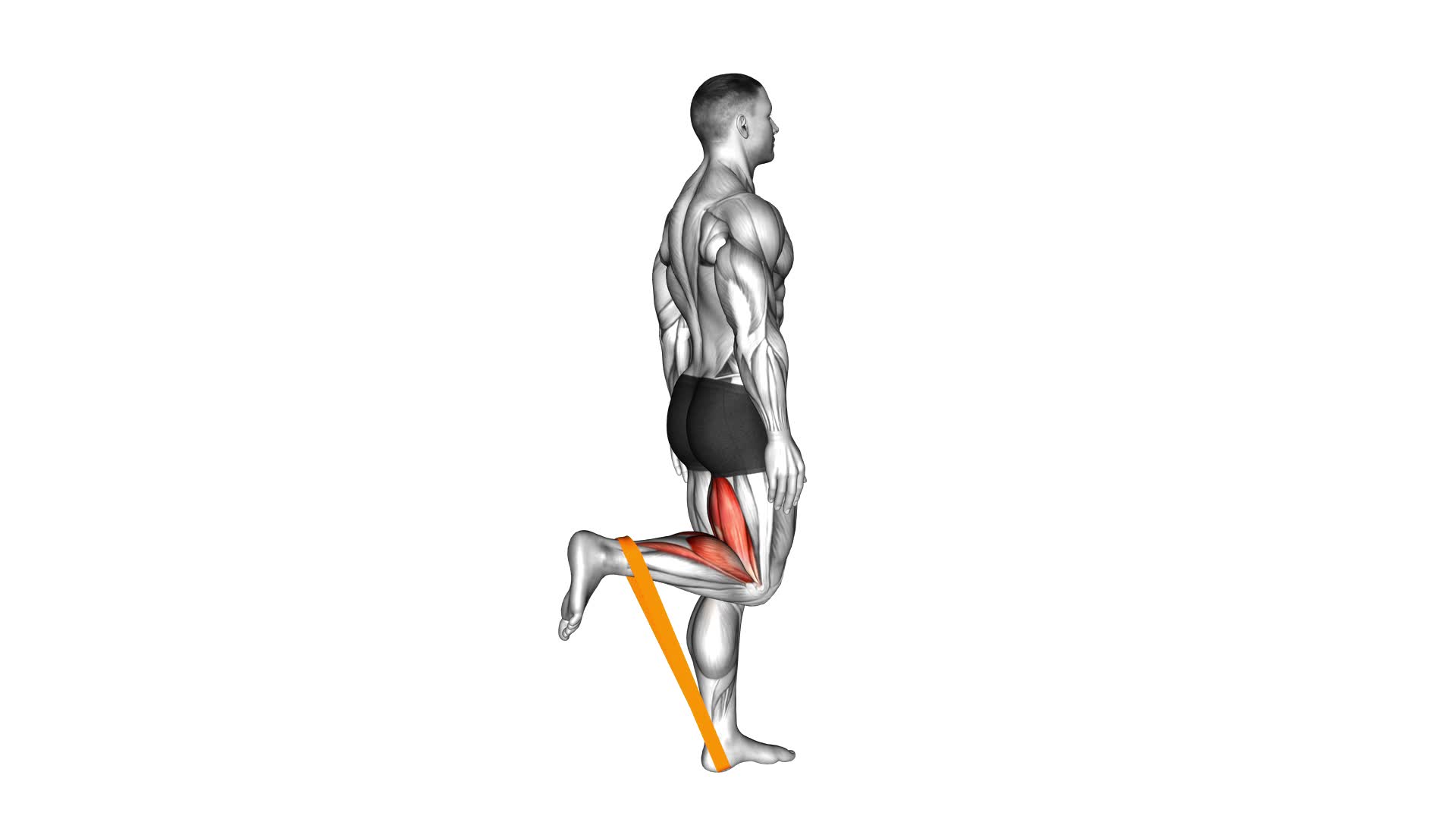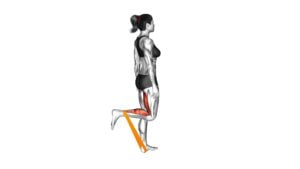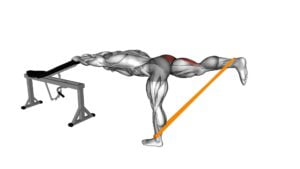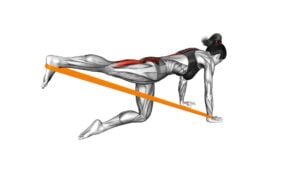Resistance Band Leg Curl (male) – Video Exercise Guide & Tips

Are you looking to strengthen your leg muscles using resistance bands?
Watch This Exercise Video
In this video exercise guide, we will show you how to perform the resistance band leg curl specifically designed for males.
This exercise targets your hamstrings and glutes, helping you build strength and tone in your lower body.
With proper form and technique, you can maximize the benefits of this exercise.
Get ready to feel the burn and achieve those leg goals with our helpful tips and variations.
Let's get started!
Key Takeaways
- Resistance band leg curls can improve hamstring strength and enhance lower body strength and stability.
- Resistance band leg curls help prevent injuries and target the hamstrings and glutes.
- This exercise can build strength and tone in the lower body.
- Variations and progressions, such as single-leg resistance band leg curls and tempo variations, can be incorporated to further challenge and engage the muscles.
Benefits of Resistance Band Leg Curl
You can experience numerous benefits from incorporating resistance band leg curls into your workout routine. One of the main advantages is the improvement in hamstring strength. Resistance band leg curls specifically target the hamstring muscles, which are located at the back of the thigh. By performing this exercise regularly, you can strengthen these muscles, leading to better overall lower body strength and stability.
Additionally, resistance band leg curls can help prevent injuries. Strong hamstrings are essential for maintaining proper posture and stability during various activities, such as running, jumping, and even everyday movements like walking and standing. Weak hamstrings can increase the risk of muscle strains, tears, and other lower body injuries. By incorporating resistance band leg curls into your routine, you can help strengthen your hamstrings, reducing the likelihood of these injuries.
Equipment Needed for Resistance Band Leg Curl
To properly perform resistance band leg curls, you'll need a few key pieces of equipment. The main equipment needed is a resistance band. Make sure to choose a band with the appropriate resistance level for your fitness level and goals. The resistance band should be long enough to loop around your ankles or feet comfortably.
Another important piece of equipment is an anchor point. This can be a sturdy pole, a door anchor, or a wall-mounted anchor. The anchor point will provide stability and ensure that the resistance band stays securely in place during the exercise. If you don't have access to an anchor point, you can use alternatives such as a heavy piece of furniture or a weight machine.
It's also important to have a mat or towel to provide cushioning for your knees and to keep your body comfortable during the exercise.
With these essential pieces of equipment, you'll be able to effectively perform resistance band leg curls and target your leg muscles for a challenging and effective workout.
Proper Form and Technique for Resistance Band Leg Curl
To ensure proper form and technique during resistance band leg curls, it's essential to maintain a stable anchor point and choose a resistance band suitable for your fitness level and goals. One common mistake isn't securing the anchor point properly, which can lead to instability and ineffective results. Make sure the anchor point is sturdy and won't move during the exercise.
Another mistake to avoid is using a resistance band that's too easy or too difficult. If the band is too easy, you won't be challenging your muscles enough. On the other hand, if the band is too difficult, you may struggle to perform the exercise with proper form, putting yourself at risk of injury. Start with a band that provides moderate resistance and gradually increase the intensity as you get stronger.
Modifications can be made to accommodate different fitness levels and abilities. For beginners or those with limited mobility, you can start by performing the leg curl exercise while seated on a chair. This will provide more support and stability. As you progress, you can gradually move to performing the exercise while standing.
In the next section, we'll discuss variations and progressions of the resistance band leg curl exercise to keep challenging your muscles and continue progressing towards your fitness goals.
Variations and Progressions of Resistance Band Leg Curl
As you progress in your resistance band leg curl routine, there are various variations and progressions that can be implemented to further challenge your muscles and continue advancing towards your fitness goals.
Here are some options to consider:
- Single-leg resistance band leg curl: Instead of using both legs simultaneously, perform the exercise with one leg at a time. This increases the difficulty and places more emphasis on each leg individually.
- Elevated resistance band leg curl: Elevate your hips by using a step or bench while performing the leg curl. This variation increases the range of motion and engages your hamstrings and glutes even more.
- Resistance band deadlift: Incorporate a resistance band into your deadlift routine to target your hamstrings and glutes. This exercise not only strengthens your legs but also improves your overall lower body strength.
- Tempo variations: Experiment with different tempos during the leg curl exercise. Slow down the movement to increase time under tension and make the exercise more challenging. You can also try explosive movements to add power and speed to your routine.
Tips for Getting the Most Out of Resistance Band Leg Curl
Maximize your results with these tips for getting the most out of resistance band leg curls.
To increase resistance and make the exercise more challenging, you can try using a thicker resistance band or doubling up on bands. This will provide more tension and help you build stronger leg muscles. Additionally, you can adjust the positioning of the band on your legs. Placing it higher up on your thighs will target your hamstrings more, while positioning it lower towards your ankles will engage your calves.
To ensure proper form and avoid common mistakes, it's important to maintain control throughout the movement. Avoid swinging your legs or using momentum to lift the band. Instead, focus on a slow and controlled motion, squeezing your hamstrings at the top of the movement. It's also crucial to keep your core engaged and your back straight throughout the exercise.
Another common mistake to avoid isn't fully extending your legs at the bottom of the movement. Make sure to fully straighten your legs before beginning the next repetition. This will ensure that you're effectively working your hamstrings and getting the most out of each rep.
Frequently Asked Questions
Can Resistance Band Leg Curls Help Improve Athletic Performance?
Resistance band leg curls can be beneficial for improving athletic performance. By targeting the muscles in your legs, this exercise helps to strengthen and tone them, which can enhance your overall power and speed.
The resistance provided by the bands also adds an extra challenge, making the exercise more effective in building muscle strength.
Incorporating resistance band leg curls into your training routine can contribute to better athletic performance by improving your leg strength and stability.
Are There Any Potential Risks or Injuries Associated With Resistance Band Leg Curls?
Resistance band leg curls can have potential risks and injuries if not performed correctly. These exercises can put strain on your knees and hips if you have improper form or use a resistance band that's too strong.
It's important to start with a lighter band and gradually increase resistance as you build strength. If you have knee or hip issues, it's best to consult with a professional or modify the exercise to avoid further injury.
Alternatives or modifications may be necessary for those with limited mobility.
How Often Should Resistance Band Leg Curls Be Performed for Optimal Results?
To achieve optimal results with resistance band leg curls, it's important to consider the frequency of your workouts.
The effectiveness of this exercise depends on how often you perform it. Find a balance between challenging your muscles and allowing them to recover.
For best results, aim to incorporate resistance band leg curls into your workout routine 2-3 times a week. This will give your muscles enough time to rest and grow while still providing enough stimulus for progress.
Can Resistance Band Leg Curls Be Done by Individuals With Knee or Hip Issues?
Resistance band leg curls can be a great exercise for knee rehabilitation and hip strengthening. By using resistance bands, you can perform this exercise without putting excessive stress on your knees or hips. The bands provide a controlled resistance that allows you to gradually build strength in these areas.
However, it's important to consult with a healthcare professional or a qualified trainer to ensure that resistance band leg curls are safe for you, given your specific knee or hip issues.
Are There Any Modifications or Alternatives for Resistance Band Leg Curls for Individuals With Limited Mobility?
If you have limited mobility and are unable to perform resistance band leg curls, there are modified exercises and alternative equipment available.
These modifications can help you target the same muscles without putting strain on your knees or hips.
You may try seated leg curls using a machine or performing glute bridges with a resistance band around your thighs.
These exercises can still provide a challenging workout while accommodating your specific needs.
Conclusion
In conclusion, the resistance band leg curl is a highly effective exercise that targets the muscles in your legs. With the proper form and technique, this exercise can help strengthen your hamstrings and improve your overall lower body strength.
By incorporating variations and progressions, you can continue challenging your muscles and seeing progress. Remember to use the appropriate equipment and follow the tips provided to maximize the benefits of this exercise.

Author
Years ago, the spark of my life’s passion ignited in my mind the moment I stepped into the local gym for the first time. The inaugural bead of perspiration, the initial endeavor, the very first surge of endorphins, and a sense of pride that washed over me post-workout marked the beginning of my deep-seated interest in strength sports, fitness, and sports nutrition. This very curiosity blossomed rapidly into a profound fascination, propelling me to earn a Master’s degree in Physical Education from the Academy of Physical Education in Krakow, followed by a Sports Manager diploma from the Jagiellonian University. My journey of growth led me to gain more specialized qualifications, such as being a certified personal trainer with a focus on sports dietetics, a lifeguard, and an instructor for wellness and corrective gymnastics. Theoretical knowledge paired seamlessly with practical experience, reinforcing my belief that the transformation of individuals under my guidance was also a reflection of my personal growth. This belief holds true even today. Each day, I strive to push the boundaries and explore new realms. These realms gently elevate me to greater heights. The unique combination of passion for my field and the continuous quest for growth fuels my drive to break new ground.



